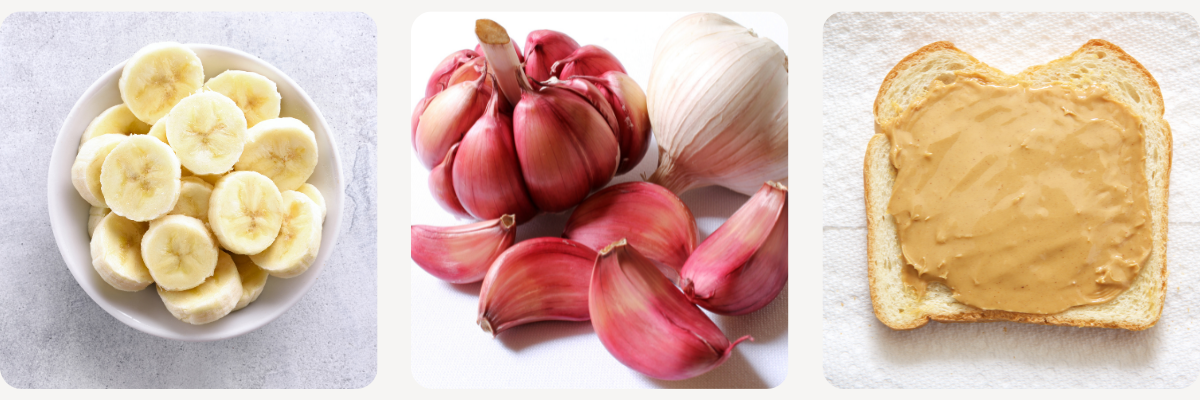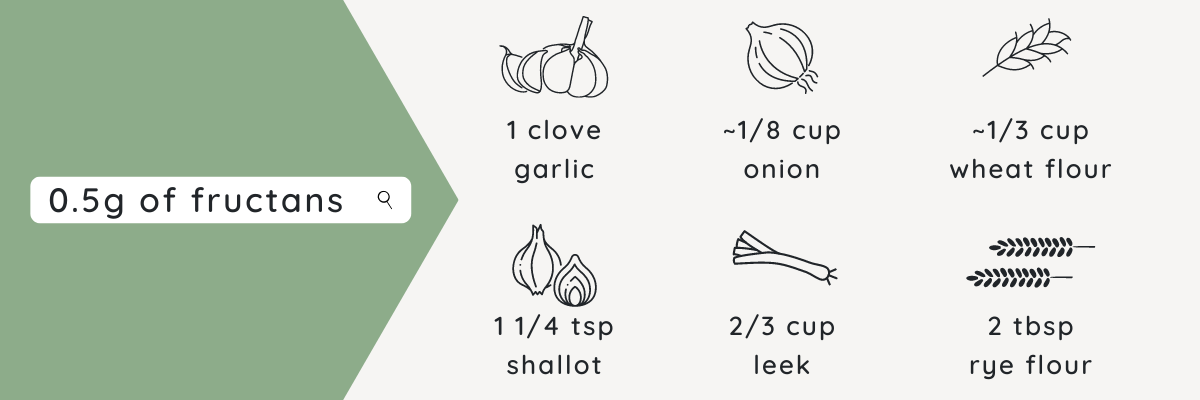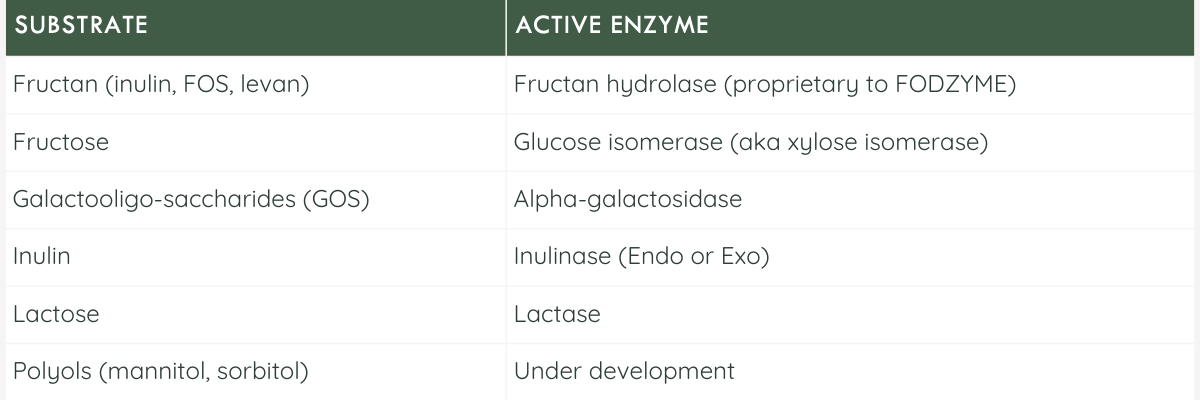Are all FODMAPs created equal?
The most common FODMAP triggers and how to support FODMAP tolerance

The most common FODMAP triggers
Peel back the onion (or garlic!) on the difference between fructan vs. fructose intolerances.
Fructose vs. Fructans
Fructose (the 'F' in FODMAP) is a simple sugar, or monosaccharide. Fructans (the ‘O’ in FODMAP) are long chains of fructose, typically with a sucrose (fructose + glucose) molecule at one end.
Plants contain a wide variety of differently branched and elongated fructans, which each provide a unique source of energy and defense for plants. In nature, a plant's stage of maturity, nutritional status, and exposure to stress all contribute to differences in fructan content, abundance, and diversity. Read more here if you really want to nerd out on fructans and all the kinds beyond inulin.

Fructose is mainly absorbed in the small intestine through diffusion by the GLUT5 transporter, which has a relatively low capacity for absorption [1]. The body's ability to absorb fructose is much greater when glucose is present, so the ratio of glucose:fructose is important (at least 1:1 is ideal). Some people have fewer or worse functioning GLUT5 transporters while others simply consume more fructose than their body can absorb. Excess fructose in the digestive tract has an osmotic effect and draws water in to the colon.
Fructans, on the other hand, are metabolized quite differently. Only about 5-15% of dietary fructans are absorbed; the rest are excreted or fermented by bacteria in the colon [2]. Fructans serve as prebiotic fibers and support production of beneficial short-chain fatty acids when fermented by gut bacteria. The body does not produce enzymes to break down fructans (or GOS or polyols for that matter).
Both fructose and fructans are associated with gas and bloating. Fructose intolerance often results in diarrhea, while abdominal pain is more common with fructan intolerance.
The Most Common FODMAP Triggers
Everyone has a limit to the amount of fructose and fructans they can tolerate. For those with IBS that threshold is unfortunately often very low.
Fructans are increasingly recognized as one of the most common FODMAP triggers. In a recent study, US patients with IBS who respond well to a low FODMAP diet underwent a blinded, cross-over reintroduction trial of all 5 FODMAPs. The researchers identified fructans and GOS as most associated with worsening abdominal pain and/or bloating [3].
Similar research in Belgium also identified fructans and mannitol as the most common FODMAP triggers during reintroduction [4]. While the prevalence of lactose intolerance in IBS varies widely (27-72%), we know many genetically susceptible patients may exhibit some level of intolerance [5,2].
Tolerance Thresholds

Fructose tolerance thresholds also tend to be much higher for fructose than for fructans. It takes an additional 10.5-21g of fructose per day to increase symptoms in patients who respond to a LFD while it takes just 0.75-1.5g of fructan to induce symptoms [3]. If FODZYME were to degrade the entire fructan content of one clove of garlic (0.5g), this would add ~0.5g of extra fructose to the meal.
The average American diet contains about 3.91g of fructan per day [2]. A single dose of FODZYME can break down 3g of fructan, which is equal to about 6 cloves of garlic [7,8].
Also remember that fructose causes issues when consumed in excess of glucose because glucose aids in the absorption of fructose. As long as the glucose:fructose ratio is maintained at roughly 1:1, maximum fructose absorption is supported. Most fructan-containing foods contain enough glucose to balance out the fructose liberated in the digestive tract.
Also of note: Specific fructose-targeting enzymes also exist (not in FODZYME) for those who are particularly sensitive to fructose. The enzyme glucose isomerase (aka xylose isomerase) works by changing the structure of fructose from the monosaccharide fructose to another monosaccharide, glucose. Treatment for rare hereditary fructose intolerance prescribes avoidance of all fructose, sucrose and sorbitol.

Form Meets Function
We designed FODZYME to address the most common FODMAP triggers, both those we know are most implicated in symptoms and those which are most abundant in the typical diet. With just a bit of dextrin to stabilize the enzymes, our targeted formula is free of any other potential gut irritants.
This means we can maximize the amount of enzymes addressing the triggers we know are most likely to be driving symptoms. In particular, our fructan hydrolase is the only enzyme available that targets the wide range of fructans found in the wild (aka the fruit and veggie aisle).
References
[1] Wilder-Smith CH, Li X, Ho SS, et al. Fructose transporters GLUT5 and GLUT2 expression in adult patients with fructose intolerance. United European Gastroenterol J. 2014;2(1):14-21.
[2] Fedewa A, Rao SS. Dietary fructose intolerance, fructan intolerance and FODMAPs. Curr Gastroenterol Rep. 2014;16(1):370.
[3] Eswaran SL, Singh P, Rifkin S, et al.. Su576 are all FODMAPS created equal? A blinded, randomized reintroduction trial to determine which fodmaps drive clinical response in IBS patients. Gastroenterology 2021;160:S-745.
[4] Van Den Houte K, Colomier E, Mariën Z, et al. Efficacy of a new approach to the reintroduction phase of the low-FODMAP diet in IBS. Gastroenterology 2021;160:S76–S77.
[5] Domżał-Magrowska D, Kowalski MK, Małecka-Wojciesko E. The incidence of adult type hypolactasia in patients with irritable bowel syndrome. Prz Gastroenterol. 2023;18(1):110-114.
[6] Singh P, Tuck C, Gibson PR, Chey WD. The Role of Food in the Treatment of Bowel Disorders: Focus on Irritable Bowel Syndrome and Functional Constipation. Am J Gastroenterol. 2022;117(6):947-957.
[7] Ochoa, Kenny Castro, et al. In Vitro Efficacy of Targeted Fermentable Oligosaccharides, Disaccharides, Monosaccharides, and Polyols Enzymatic Digestion in a High-Fidelity Simulated Gastrointestinal Environment. Gastro Hep Advances. 2023;2(3):283-290.
[8] Muir JG, Rose R, Rosella O, et al. Measurement of short-chain carbohydrates in common Australian vegetables and fruits by high-performance liquid chromatography (HPLC). J Agric Food Chem. 2009;57(2):554-565.

